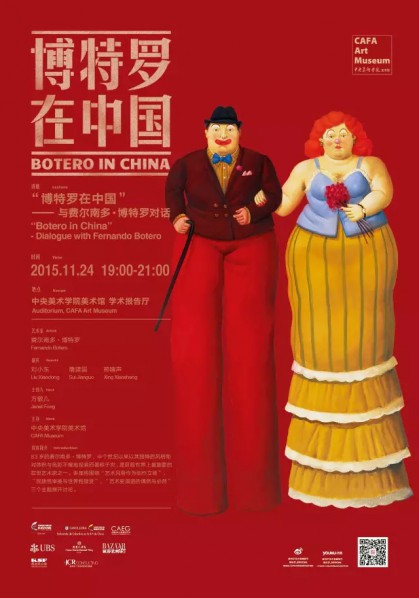
The academic lecture will center on three themes in terms of “The Vigor of Style in Art as Creation Standpoint”, “The National Aesthetics and International Acceptance”, and “The Contingency and Inevitability in the Evolution of Art History”.
Talk 1: Fernando Botero, Xing Xiaosheng
Talk 2: Fernando Botero, Liu Xiaodong, Sui Jianguo
Time: 7:00pm-9:00pm, November 24th (Tuesday), 2015
Venue: the CAFA Art Museum (Address: No.8 South Huajiadi Street, Chaoyang District, Beijing)
Honored Guests: Fernando Botero, Xing Xiaosheng, Liu Xiaodong, Sui Jianguo
Moderator (second section): Janet Fong
Theme 1: The Vigor of Style in Art as Creation Standpoint
In Botero’s artistic world, we can find his strong spiritual power based on the reality and we also can see the subject matters of his continuous consideration and concern about the world, which are reflected on his works of art. In his hands, he employs his unique painting technique to express natural and man-made calamities, tears of sadness, man-made unfair events……He draws what he sees and what he thinks. He makes his ideas stand out in the commonplace society and shows to the viewers his ideas with the vigor of the style deeply carved in his works.
Every artist is inevitably influenced by the era and the society he lives in. The guest speakers will expound what are the criteria of the vigor of style in their minds from various perspectives and explain as well how to convey to the audience the images and the expression of ideas, their understandings and attitudes towards the world and the life via artistic language.
Theme 2: The National Aesthetics and International Acceptance
The 83-year-old Fernando Botero has been renowned for his recognizable style and continuous exploration of volume and color since the past half century. His early paintings and drawings were inspired by the engravings of Gustave Dore and the posters on bullfight. His works cover a wide range of contents. The subject matters not only summarize his artistic accomplishments and personal background, the Colombian and Latin American culture and art, but also depict symbolically the important evolution of contemporary art in the world. His description of the local scenery and culture in Colombia and Latin America of his childhood has a rare universality.
It is always said that “National uniqueness leads to the path of international acceptance”. Every nation has unconscious collective aesthetic standard. When the works are in conformity with the national aesthetic standard and understood and appreciated by other nationalities as well, the worldwide artistic acceptance will occur. In the context of Internet, how can we maintain the connection between the national individualistic aesthetics and the international acceptance? What factors contribute to the fact that Botero’s works with such a distinctive national style are world widely accepted? With what methods, means and forms are the outstanding national arts shared together with the people all over the world but not homogenized? The guest speakers will discuss how the questions above have a reference and an enlightening significance for Chinese contemporary art.
Theme 3: The Contingency and Inevitability in the Evolution of Art History
Botero has been engaged in painting and sculpture and made remarkable achievements in both fields. In the field of painting, he was much influenced by the old masters of Renaissance in Italy. In combination with the folk traditions of his hometown Medellin and in particular, in accordance with his own features and pursuit, he traditionally created paintings on ordinary canvases with ordinary oils, via a little deformed plastic style, with the intention of embracing the world and to observe it with his cool-headed eyes. However, his paintings are characteristic of modernism, for his visions differ from those of the ancient people as well as today’s people, given that they only belong to this artist who lives in the modern world and who has also proved himself in another form of artistic expression—— sculptures.
The inevitable reason for an artist to be introduced into the annals of history is attributable to his crucial role in the contributions to the evolution of art history. Botero’s works of art have their own unique styles, ranging from strong colors, extremely volumetric objects, completely free physical proportions and flexible expansion of lines to the expression of beauty and sculptural effect brought by the volume through the subject matters of real life. From what angle is Botero selected in the art history, with regard to his works ranging from “idea” to “form” to the new “style”? Is this an unavoidable choice in the evolution of art history or does Botero’s occasional emergence enrich the art history? What enlightenments can that bring to the growth of young contemporary artists? The honored guests will have an in-depth analysis on the above questions from their own perspectives.
About the artist
Fernando Botero, born in Medellin, Colombia in 1932, is frequently mentioned as the world’s most important living artist. His art works originate from traditional western art but possess strong and positive elements from Colombian culture. With a style that is easily recognized and celebrated in every corner of the world, he has maintained throughout his career consistency and coherence in the exploration of volume and color while depicting scenes from the memories of his childhood in Colombia and Latin America. He is heavily influenced by the works of the Great Masters in the History of Art and prides himself on his respect and love of the artistic tradition that preceded him. Over a career spanning more than 60 years, he is one of the world’s most versatile artists, expressing his aesthetic convictions through the exploration of a myriad of mediums and techniques. At the height of his career, he has earned the honor of being the living artist with the most museum exhibitions and the most books and films made about him. Today, Botero persists in his natural mission of creating.




























